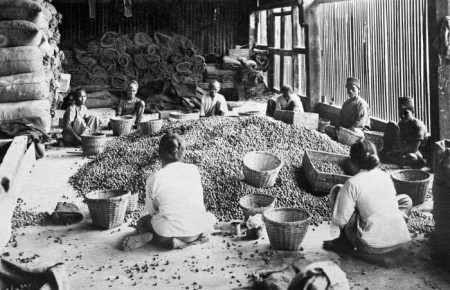I live in Connecticut, also known as the “Nutmeg State.” It finally occurred to me to look into how our state earned this moniker. It turns out the history of nutmeg is fraught with drama and horror. And what does all of this have to do with Manhattan? Read on.
 Nutmeg is not a nut, but a seed of an evergreen tree called Myristica fragrans. The same tree also produces mace.
Nutmeg is not a nut, but a seed of an evergreen tree called Myristica fragrans. The same tree also produces mace.
It’s been a prized spice across cultures for centuries. Medieval and Renaissance societies thought it was an aphrodisiac and also believed it could ward off plague. Up until the mid-19th century, the only place you could find nutmeg was in Indonesia, on a small range of volcanic islands known as the Bandas. The smallest one, called Pulau Run (later called just “Run” by the Europeans) was chock-a-block with nutmeg trees. Arab traders sold nutmeg to Venetians for high prices, but kept the location a secret. Nutmeg was hugely expensive, and therefore a big status symbol for wealthy Europeans.
Finally in the early sixteenth century, the Portuguese invaded the area and discovered the source. By the end of the sixteenth century, the Dutch took over, and gained control of the islands. This is where the horror part comes in.
The Bandanese were coerced into signing a contract that stated they could only sell nutmeg to the Dutch, which gave the Dutch an effective monopoly on nutmeg. In exchange, they’d receive useless trade items, like heavy woolen cloth that was completely worthless in a tropical climate. Also, the soil conditions of the island were only suited for growing nutmeg, and not much else, And Bandanese nutmeg growers were used to trading nutmeg to neighboring islanders for things like, gee, food. Naturally, they went back to dealing with their usual Asian and European trading partners. The Dutch knew the treaty was impossible to comply with, but they used the Bandanese violation of it as an excuse to “step in.” In 1621 they executed forty of the leaders, put their heads on pikes, massacred most of the inhabitants of the island, forcibly expelled the rest, and imported slaves and convicts to do the work, overseen by Dutch plantation owners. It soon occurred to the Dutch that no one knew how to grow nutmeg, so the few remaining Bandanese that had been sent elsewhere were brought back as slaves and forced to share their expertise with nutmeg cultivation.
The Dutch established nutmeg plantations on several islands. This was a time when the Dutch and British were at constant battle for control of the spice trade—which in effect was control of the world, and at some point the British gained control over the island of Run.
Finally in 1667 the two powers signed a treaty. The Dutch wanted their nutmeg monopoly back, and also a part of South America controlled by the British that produced sugar. The British wanted the island of Manhattan. So they swapped. New Amsterdam became New York. The Dutch got their nutmeg and sugar.
Oh and as far as Connecticut being nicknamed the Nutmeg State? From what I can determine, it was rumored that some dishonest Connecticut traders tried selling fake nutmeg they’d whittled from wood. So I guess the nickname implies we’re “the fraudster state.” Nice. A more recent theory is that real nutmeg really is wood-like, and Connecticut traders were falsely deemed fraudsters by certain southerners who claimed they’d bought “fraudulent” nutmeg. But in fact they were unaware that it had to be grated.*
*http://mentalfloss.com/article/55245/why-connecticut-called-nutmeg-state
CARLSON D, JORDAN A. Visibility and Power: Preliminary Analysis of Social Control on a Bandanese Plantation Compound, Eastern Indonesia. Asian Perspectives: Journal Of Archeology For Asia & The Pacific [serial online]. Fall2013 2013;52(2):213-243. Available from: Academic Search Complete, Ipswich, MA. Accessed May 26, 2015.
